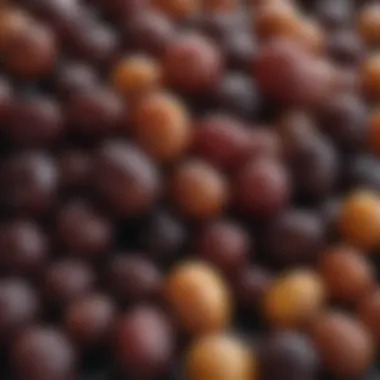Understanding the Risks of Raisins for Dogs' Health


Intro
Raisins, a seemingly harmless snack for humans, present a serious risk to dogs. Understanding this relationship is critical for pet owners. This article will delve into the toxicity of raisins, the biochemical processes that contribute to this danger, and practical steps to keep dogs safe.
Key Points to Discuss
- Toxicity of Raisins: The chemical compounds in raisins that affect dogs' health.
- Symptoms of Illness: Signs to watch for if a dog consumes raisins.
- Preventive Measures: How responsible pet owners can protect their furry friends.
- Background Information: Raising awareness about dietary risks for dogs
Understanding these topics can help create a safer environment for our pets. This article aims to empower dog owners with knowledge that could potentially save their pets’ lives.
The Toxicity Concern
The concern surrounding raisins and their potential toxicity to dogs cannot be overstated. Understanding this topic is paramount for pet owners and the veterinary community alike. The widespread use of raisins in various human foods makes it crucial for dog owners to recognize the dangers they pose. This section outlines the significance of raisin toxicity, the risks involved, and the essential knowledge required to safeguard canine health.
Understanding Raisin Toxicity
Raisin toxicity is linked to the consumption of both raisins and grapes. While the exact toxic compound remains unknown, the consequences can be severe. Dogs exposed to even small amounts can suffer acute kidney failure. Awareness of the signs of toxicity is vital. When ingestion occurs, immediate awareness can be life-saving. Symptoms may not appear right away, which adds to the challenge. The delay in symptom manifestation can lead to misjudgment about the severity of the situation.
A study showed that not all dogs are equally affected, leading to calls for more comprehensive research into the mechanisms behind this toxicity. The variability in the response to raisins among individual dogs demonstrates that even breed and size must be considered. As a pet owner, it is necessary to understand that the effects of consumption can be serious enough to justify professional intervention.
Why Some Dogs Are Affected
The reasons why certain dogs experience toxicity while others do not is still a mystery. Factors such as genetics, breed, and even previous exposure may play significant roles. For instance, certain breeds may be more susceptible to developing toxic reactions. Larger dogs may seem better equipped to handle the ingestion, but this assumption can be misleading.
Moreover, it has been suggested that the dog's individual metabolical processes may influence how toxins are processed within their bodies. Notably, dogs that have pre-existing health conditions might be at higher risk. This unpredictability presents a challenge in understanding which dogs are at higher risk. It's important to assume that any dog can potentially react adversely.
Biochemical Mechanism of Action
The exploration of biochemical mechanisms is fundamental in understanding the specific ways raisins can affect dogs. It delves into the nature of toxic reactions that occur at a cellular level. By knowing the biochemical foundation, pet owners can grasp why some dogs are at a greater risk than others. This understanding enhances the overall approach to dog nutrition and health management, offering better preventive measures and informed choices.
Identification of Toxic Compounds
Raisins contain certain substances that experts believe lead to toxicity in dogs. These compounds are not well-defined, yet they are known to trigger acute kidney injury in some canines. Some researchers propose that naturally occurring tartaric acid or some form of mycotoxins may exist in raisins. Although the exact compounds responsible remain unidentified, what is apparent is their potential to disrupt normal kidney function.
The variance in reactions among different dogs suggests there might be other contributing factors such as genetic predisposition or existing health conditions. Therefore, understanding these compounds remains vital for those who wish to prevent potential health crises.
How Dogs Metabolize Raisins
The metabolism of raisins in dogs is complex and poorly understood. When ingested, raisins enter the dog's digestive system and are broken down through metabolic processes. However, the critical function occurs in the kidneys, where toxins are typically filtered out of the bloodstream. In some dogs, this filtration process fails, leading to the accumulation of harmful substances that result in acute toxicity.


Interestingly, not all dogs experience this toxic response even after eating raisins. Some studies suggest that certain breeds are more susceptible than others. Therefore, if a dog consumes raisins, pet owners should monitor any unusual behavior or symptoms immediately. This knowledge is crucial in ensuring the safety of our canine companions.
“Understanding the biochemical mechanisms provides the foundation for effective prevention and incident management in cases of raisin toxicity.”
Symptoms of Raisin Toxicity
Understanding the symptoms of raisin toxicity in dogs is crucial. Early detection can significantly affect the outcome. Raisins can cause acute kidney failure in dogs. Therefore, being aware of the signs can save lives. Pet owners must learn what to look for when their dog ingests raisins or grape-like foods. Prompt response is key.
Initial Signs to Note
When a dog has ingested raisins, the first signs might appear within a few hours. Some of the most common initial symptoms include:
- Vomiting: This is usually the first response the dog’s body has to the toxin. Dogs may vomit multiple times, which further stresses their system.
- Diarrhea: Loose stools often accompany vomiting. This can be a sign that the body is trying to expel the toxic substance.
- Lethargy: Affected dogs may show reduced energy levels. They might seem unusually tired and less interested in their usual activities.
These signs may be mild but should never be dismissed. Pet owners should monitor their dogs closely after potential exposure to raisins.
Progressive Symptoms and Their Implications
If raisin toxicity progresses, symptoms can become more severe. This is when immediate veterinary intervention becomes critical. Here are the later signs:
- Increased Thirst: Dogs may drink more water as their kidneys begin to fail. This symptom can indicate that the body is trying to cope with the toxin’s effects.
- Frequent Urination or Lack of Urination: Changes in urination patterns can signal kidney distress.
- Abdominal Pain: Affected dogs may show signs of discomfort, which could manifest as whining or reluctance to be touched.
- Signs of Dehydration: These include dry gums and skin. Dehydration can occur quickly in dogs, especially if vomiting and diarrhea are present.
- Seizures: In severe cases, dogs may experience seizures caused by toxin buildup in their system.
These progressive symptoms highlight the urgency of the situation. Failing to address the issue immediately can lead to irreversible kidney damage or death.
The implications of these symptoms vary. Some dogs can recover if treated promptly, while others may face long-term health challenges. This emphasizes the importance of being knowledgeable about the risks and acting quickly when necessary.
Preventive Measures for Pet Owners
Understanding the risks associated with raisins is crucial for any pet owner. The potential toxicity that raisins pose to dogs underlines the need for preventive measures. Implementing such strategies not only protects the health of pets but also fosters a safer home environment.
Understanding Safe Food Practices
To minimize the risks associated with feeding dogs potentially toxic foods like raisins, it's essential to cultivate safe food practices. This begins with a clear understanding of what human foods are harmful to dogs. Educating oneself on harmful foods is the first step. Raisins, alongside grapes, chocolate, onions, and many others, can have adverse effects. By knowing what foods to avoid, pet owners can better safeguard their dogs.
In addition to avoiding harmful foods, proper storage of food items is a practical measure. Keeping raisins and similar items out of reach is critical. Store them in cabinets or containers that dogs cannot access.
Moreover, reading labels on pet food and treats is important. Many commercial dog treats may contain ingredients that are toxic. Pet owners should ensure that the treats they give are made from safe, dog-friendly ingredients. The use of transparent communication with veterinarians allows for better understanding of dietary options for dogs.
Alternatives to Raisins in Dog Diets
Providing safe alternatives to raisins in a dog's diet is an effective way to manage their nutrition without risking their health. Instead of raisins, pet owners can consider using carrot sticks, pumpkin, or blueberries. These fruits and vegetables provide essential nutrients and are generally safe for dogs.


- Carrot Sticks: These are low in calories and high in fiber. They keep the dog busy and contribute to dental health.
- Pumpkin: Packed with vitamins, pumpkin also aids digestive health in dogs.
- Blueberries: Rich in antioxidants, blueberries offer health benefits without the risks associated with raisins.
It's important for pet owners to introduce new foods gradually and monitor for any signs of allergies or intolerance. Consulting a veterinarian about diet changes can further tailor the approach to suit the individual needs of the dog.
Always prioritize the dog's health by choosing safe and nutritious foods. Making informed choices will help avoid the potential dangers that some common foods can present.
If Ingestion Occurs
Ingesting raisins represents a serious health risk for dogs. Understanding what to do if this occurs is essential for pet owners. This section provides crucial steps and considerations regarding immediate actions and when to seek veterinary assistance. The sooner a dog receives attention after eating raisins, the better the chances for a favorable outcome. Pet owners must act quickly and with purpose.
Immediate Steps to Take
If you suspect that your dog has ingested raisins, the first step is to remain calm. Panicking can lead to hasty decisions that may not benefit your pet. Here is what you should do:
- Remove Access: Ensure that your dog cannot access any remaining raisins or other harmful foods. Secure areas where food is kept.
- Check for Symptoms: Observe your dog for any initial signs of distress, which may include vomiting or lethargy.
- Do Not Induce Vomiting: Unless directed by a veterinarian, do not attempt to induce vomiting. This can sometimes do more harm than good, especially if the dog is already exhibiting signs of toxicity.
- Contact Your Veterinarian: Inform your vet about the situation. Provide them with details such as the dog's size, breed, and the approximate amount of raisins consumed.
Taking these immediate actions can greatly influence outcomes. Prompt response may help to minimize the risk of severe health complications.
When to Seek Veterinary Help
It is critical to seek veterinary assistance as soon as possible, regardless of whether symptoms are present. Here are key points to guide when to contact a vet:
- In any case of ingestion: Even if the dog looks fine initially, the delayed onset of symptoms can occur. For example, kidney failure may not manifest until hours or even days after ingestion.
- Presence of Symptoms: Should your dog show any symptoms such as vomiting, diarrhea, or decreased energy, it is crucial to seek immediate veterinary care.
- Lack of Response: If your dog appears to decline over time or if you notice unusual behavior, do not hesitate to consult a veterinarian. The animal's health can deteriorate rapidly with raisin toxicity.
In summary, understanding the risks associated with raisin ingestion in dogs requires proactive measures. Knowing how to act swiftly can significantly affect recovery and well-being. Always prioritize communication with your veterinarian and be vigilant about your dog's diet.
The Role of Veterinary Care
Veterinary care plays a crucial role in addressing the risks associated with raisins and their potential toxicity in dogs. Often, pet owners may not be aware of the dangers that raisins pose, and timely veterinary intervention can make a significant difference in the outcome for affected dogs. Understanding the elements of veterinary care concerning this issue highlights the importance of proactive measures for pet owners.
Diagnosis of Raisin Toxicity
Diagnosis begins with a thorough examination of the dog and a detailed history from the pet owner. Veterinarians assess the symptoms and their severity. Initial tests, such as blood work, help evaluate kidney function and other organ systems affected by toxicity. The challenge lies in the variability of reactions to raisins. Not all dogs show the same symptoms or severity of toxicity after ingestion. Therefore, recognizing the signs and seeking professional help promptly is essential. Common signs include vomiting, diarrhea, and lethargy, and these can escalate to severe kidney damage if left untreated.
Treatment Options and Their Effectiveness
Once diagnosed, the veterinarian will recommend treatment based on the dog’s condition. Options may include:
- Inducing Vomiting: If ingestion occurred recently, a veterinarian may induce vomiting to prevent further absorption of toxins.
- Activated Charcoal: Administering activated charcoal can help absorb remaining toxins in the gastrointestinal tract.
- Intravenous Fluids: Providing fluids is critical for supporting kidney function and helping to flush toxins from the dog's system.
- Monitoring: Close monitoring is necessary to assess kidney function over time, adjusting treatment as needed.
The effectiveness of these treatments varies. The sooner treatment begins, the better the prognosis generally is. Continuous veterinary supervision can ensure early detection of complications that might arise, enhancing the likelihood of recovery.


"Early intervention is key in managing raisin toxicity. Understanding symptoms and recognizing the urgency of veterinary care can save a dog's life."
Long-term Effects and Prognosis
Understanding the long-term effects and prognosis of raisin toxicity in dogs is an essential aspect of this article. Knowledge in this area can have significant benefits for both pet owners and veterinary professionals. Many pet owners may be unaware of the lasting impacts that ingesting raisins can have on a dog's health. By grasping the potential long-term consequences, responsible decisions regarding dietary choices and immediate responses to ingestion can be made.
Understanding Kidney Function Post-Toxicity
Raisins can induce kidney damage in dogs, leading to acute kidney injury. The kidneys play a crucial role in filtering waste from the blood, maintaining electrolyte balance, and regulating blood pressure. When a dog consumes raisins, the risk of renal failure can pose serious long-term health consequences.
Research shows that even if a dog recovers after treatment, there can still be complications related to kidney function. It is essential for pet owners to understand that any renal injury is not necessarily reversible. Some dogs may face chronic kidney disease later in life, which requires ongoing management and potential dietary adjustments.
Key aspects of kidney function post-toxicity include:
- Monitoring Blood Work: Regular veterinary check-ups to assess kidney function through blood tests.
- Understanding Symptoms: Recognizing signs of potential kidney issues, such as increased thirst, lethargy, or changes in appetite.
- Dietary Considerations: Adapting the dog's diet to support renal health post-recovery.
Monitoring Recovery in Affected Dogs
After a dog has been treated for raisin toxicity, close monitoring is vital. Pet owners need to observe their pets for any recurring or new symptoms. Even slight changes in behavior can indicate underlying health issues.
Here are some steps to consider for effective monitoring:
- Regular Veterinary Appointments: Scheduling follow-up visits to evaluate the dog's recovery trajectory.
- Maintain a Symptom Diary: Keeping track of any behavioral or physical changes can provide valuable insights for veterinarians.
- Hydration Management: Ensuring the dog has access to fresh water to prevent dehydration, which can complicate kidney recovery.
- Adjusting Activity Levels: Gradually reintroducing exercise based on the dog’s physical condition.
Pet owners should be proactive. Early detection of problems can result in better outcomes. Awareness is critical. Changes to a dog's health after raisin ingestion require immediate attention.
Understanding the long-term effects of raisin toxicity enables responsible pet ownership and effective veterinary intervention.
Educating the Community
Educating the community about the risks of raisins for dogs is a crucial aspect of pet ownership. Awareness can significantly reduce the incidence of raisin toxicity, which poses serious health risks. Many pet owners are unaware that common household items like raisins can be harmful. Therefore, sharing knowledge can prevent public safety issues and promote better preventative care. This education must not only reach dog owners but also spans veterinarians and trainers who can act as resources for responsible pet care.
Raising Awareness About Toxic Foods
Raising awareness about toxic foods, specifically raisins, is vital. It allows pet owners to make informed decisions for their pets’ health. Most people may not consider raisins harmful, as they are often considered a safe snack for humans. Here are several critical points to consider:
- Toxic Compounds: Many do not know the specific compounds in raisins that can affect dogs. It is essential for owners to be educated about such risks.
- Symptoms and Treatment: Informed owners can identify symptoms quickly. Early detection is necessary for effective treatment, minimizing long-term damage.
- Social Sharing: Owners can share their knowledge within their communities to amplify the message.
By creating educational campaigns, communities can effectively raise awareness about toxic foods. Workshops, social media posts, and community forums can serve as effective platforms for dissemination of this important information. Additionally, using clear and straightforward language will enhance understanding among all audience.
Community Initiatives for Responsible Pet Ownership
Community initiatives for responsible pet ownership focus on preventing incidents related to toxic foods. Engaging local vet clinics, shelters, and pet stores can aid in sharing resources and information about raisin toxicity. Some helpful initiatives include:
- Workshops and Seminars: Hosting events where experts discuss pet nutrition and dangers, including toxic foods like raisins, can draw significant participation.
- Collaborative Campaigns: Partnerships between veterinarians and local pet shops can help distribute pamphlets or flyers detailing harmful human foods.
- Social Media Engagement: Creating posts or discussions on platforms such as Facebook and Reddit can keep the community informed and engaged with the topic.
Community initiatives can foster an environment where responsible pet ownership is encouraged and supported. By focusing on education and engagement, communities can work together to minimize the risks of raisin ingestion among dogs. This proactive approach creates a culture of awareness, ultimately benefiting all pets and their owners.







